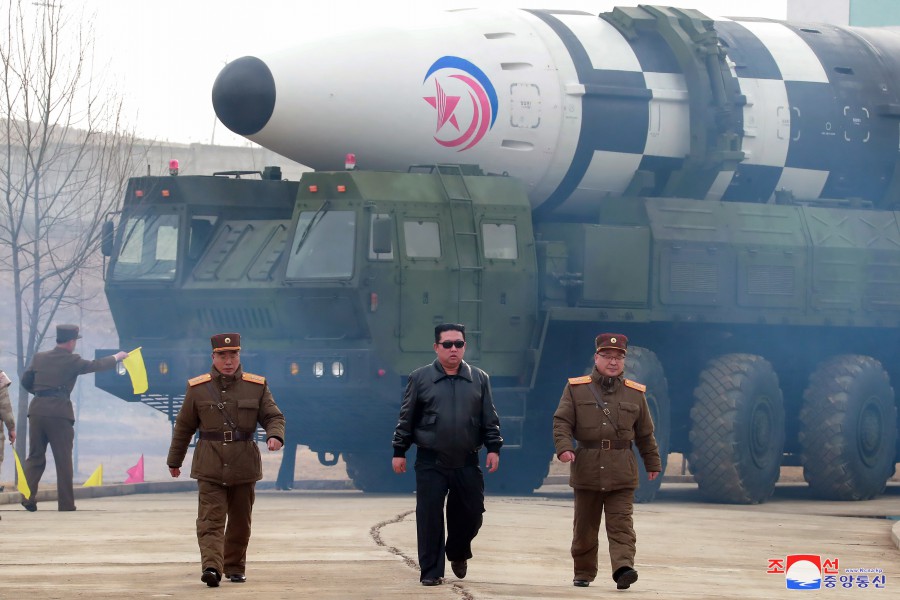
The United States needs to deploy its Next Generation Interceptor by 2028 or sooner to keep pace with North Korea’s accelerating ballistic missile program, most recently demonstrated in Pyongyang’s successful test-firing of an intercontinental ballistic missile Thursday, Air Force Gen. Glen VanHerck told the Senate Armed Services Committee.
While saying he was “comfortable with where we are today based on the intelligence I have,” the commander of U.S. Northern Command said “going forward, I do believe that [the North Koreans] could exceed my capacity and capabilities.”
Thursday’s ICBM test was North Korea’s first since 2017, but the 12th missile test this year.
State Department spokesman Ned Price condemned Thursday’s missile launch as a violation of “multiple United Nations Security Council resolutions.” It also occurred as President Joe Biden was meeting in Brussels with European Union leaders and NATO allies over next steps in confronting Russia following its invasion of Ukraine.
At the hearing, VanHerck stressed he was referring not only to the 20 Next Generation Interceptors fielding on time or earlier, but also the importance of keeping at least 44 Ground-Based Interceptors operational during that time.
The current 44 interceptors, based at Fort Greely, Alaska and Vandenberg Air Force Base, Calif., are undergoing surface life extension programs.
The pace and capacity of Pyongyang’s ballistic missile capacity means “the funding for the service life extension program for the current ballistic missile defense capability is so crucial.” In written testimony, VanHerck mentioned that submarine-launched ballistic missiles and ICBMs were indicators of North Korea leader Kim Jong-un’s continued investment in advanced systems.

Several times during the hearing, VanHerck stressed the importance of passing budgets on time to keep programs like the Next Generation Interceptor on schedule. Under continuing resolutions, programs like that are held to the previous year’s spending levels. If they were not part of the budget then, they are put on hold.
This year Congress passed an omnibus spending bill earlier this month, more than four months after the start of Fiscal Year 2022. The administration is expected to submit next year’s budget Monday.
In written testimony, VanHerck, who also serves as head of the U.S.-Canadian North American Aerospace Defense Command, said the rapid growth of North Korea’s missile program also requires “Long Range Discriminating Radar in Alaska to achieve full operational capacity on schedule.”
The two six-story sensors were in place and ready for testing late last year to better monitor North Korean activities.
When asked about the command’s ability to defend against hypersonic weapons systems he said, “I cannot defend, nor am I tasked to defend, against a hypersonic glide vehicle attack.” He added Russia has the capability now to hold high-value targets in Canada and the U.S. at risk through its arsenal of air- and sea-based conventional cruise missiles.
VanHerck said these weapons underline the need for all-domain awareness from subsea to space and the ability to determine whether, if launched, these missiles are carrying conventional or nuclear payloads. He called them “threats to the continuity of government” if the intelligence was wrong over what type of payload the missiles carried.
On the Arctic Defense Initiative, he said he is waiting for the release of the administration’s Fiscal Year 2023 budget – expected Monday – before completing work on the congressionally-requested product, to see how much money is pledged to that region’s security needs. VanHerck added he expects to turn the report in this summer.
The initiative is patterned after similar ones for Europe and the Pacific.
Saying “we must be persistent” in the Arctic, VanHerck told the panel that while work is progressing on expanding the port of Nome, Alaska, to handle Navy and Coast Guard vessels to operate on longer deployments or be stationed in the High North, the port must be dredged to 40 feet, not 30, to handle these ships.
As the situation stands now, the only Alaskan port that can now meet that requirement is Dutch Harbor, about 800 miles to the south of Nome. The deeper port would be essential to the operation of the Coast Guard’s planned six Polar Security Cutters.
The command is working with Canada on infrastructure requirements in its Arctic to better secure the region. “Operating in the Arctic is a challenge,” VanHerck said. But it is becoming an increasingly important locale for transportation along the Northern Sea Route off the Russian coast, in addition to mineral and energy exploration and production as warmer temperatures take hold.
Arctic fisheries have historically been vital for global food supply.
In prepared testimony, he said he was “excited by the opportunities for building partnerships in the Arctic and the continued shared effort to maintain the stability and security of the entire region. The upcoming Arctic Security Forces Roundtable, to be held in Alaska in May 2022, will provide the United States with a rare opportunity to host an international forum focused specifically on Arctic security and military cooperation.”
VanHerck said China’s interest in the Arctic has been steady over the past five years, sending a research vessel to its waters. He added the Chinese “are not only active in the Arctic but in the Bahamas” and the Caribbean.





